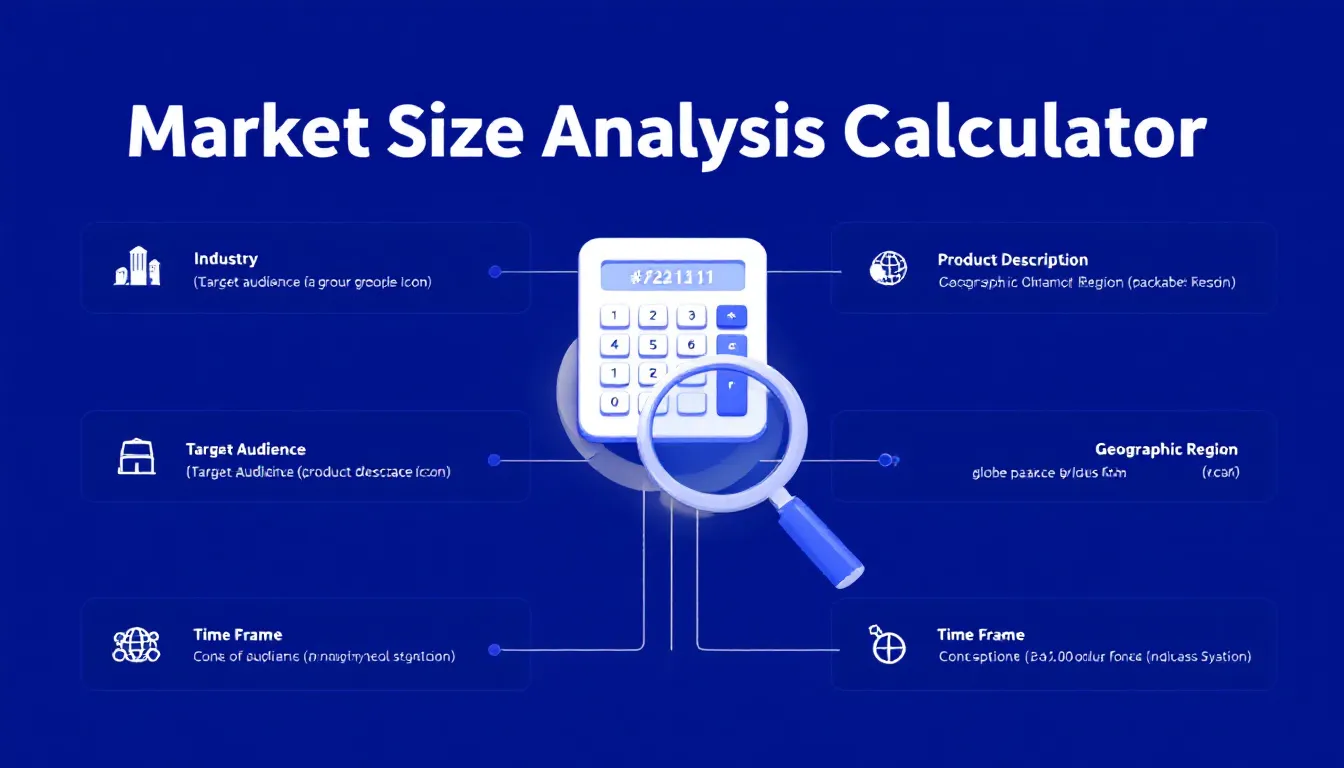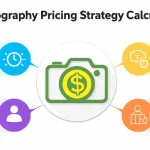Analyzing market data...
Is this tool helpful?
How to Use the Market Size Analysis Calculator Effectively
This tool helps you assess the growth potential and market size for your target audience using a clear, step-by-step input process. Below is a guide to each field, with sample inputs to help you get started:
Input Fields Explained
-
Industry or Market Segment: Enter the specific sector you want to evaluate.
Sample inputs:
- “Renewable Energy Equipment”
- “Organic Skincare Products”
-
Target Audience: Clearly define the customer group your product or service targets.
Sample inputs:
- “Freelance graphic designers in North America”
- “Parents of children aged 5-10 interested in educational toys”
- Product/Service Description: Provide a detailed explanation of your offering, highlighting unique features and benefits that meet customer needs.
- Geographic Region (Optional): Specify the market location you want to analyze, which can range from local areas to international regions.
- Analysis Time Period (Optional): Indicate the time range for your market forecast, helping you anticipate growth over that duration.
What Is the Market Size Analysis Calculator and How It Benefits You
The Market Size Analysis Calculator is a practical tool designed to evaluate your industry’s growth opportunities and overall market potential. By analyzing key parameters, it helps you make informed decisions based on data rather than assumptions.
Using this tool, you can better understand your total addressable market (TAM), identify the reachable segments, and estimate achievable market share. This insight supports refining your marketing strategies, driving smart investments, and planning business expansion effectively.
Key Benefits
- Data-Driven Strategy: Base your decisions on structured market insights rather than guesswork.
- Resource Allocation: Focus time and budget on the most promising customer segments and regions.
- Risk Reduction: Identify market challenges and key growth drivers before launching.
- Growth Forecasting: Map realistic revenue and customer acquisition targets for specific periods.
How This Market Analysis Tool Works in Practice
This tool collects your inputs through an easy-to-use form and processes them using a backend analysis system. It considers market sizing formulas and growth factors to deliver a tailored report, highlighting your market’s potential.
Below is a practical illustration of the market sizing approach it applies:
Core Market Sizing Formula
The calculation relies on this formula:
$$ TAM = N \times P \times F $$Where:
- N: Total number of potential customers in your target market
- P: Average purchase price of your product or service
- F: Purchase frequency per year
Using Practical Examples
- For a specialty coffee retailer, you might estimate:
- N: 50,000 local coffee enthusiasts
- P: $15 average spend per purchase
- F: 10 purchases per customer per year
$$ 50,000 \times 15 \times 10 = 7,500,000 $$ - For a mobile app developer targeting fitness enthusiasts:
- N: 100,000 active users
- P: $8 average subscription fee per month
- F: 12 months (annual subscriptions)
$$ 100,000 \times 8 \times 12 = 9,600,000 $$
Practical Applications and Strategic Advantages
Use Cases
- Startups: Evaluate market viability before product launch.
- Established Businesses: Identify new growth markets and customer segments.
- Marketers: Craft targeted campaigns by understanding audience size and behaviors.
- Investors: Assess business opportunities based on market data.
Problem Solving for Market Challenges
- Reduces Uncertainty: Structure input data to generate reliable forecasts.
- Focused Customer Segmentation: Clarify which groups offer the best opportunity.
- Competitive Insight: Incorporate competitor analysis for accurate positioning.
- Identifies Strategic Gaps: Highlight underserved markets and unmet needs.
Best Practices to Maximize the Market Analysis Tool’s Impact
Data Integrity and Preparation
- Use verified industry reports and trusted data sources.
- Cross-check your inputs for consistency and accuracy.
- Update market parameters regularly to reflect real-time changes.
- Document assumptions behind your estimates clearly.
Analysis Framework
- Approach analysis systematically, covering all relevant inputs.
- Consider multiple scenarios for market growth and decline.
- Factor in both quantitative data and qualitative market factors.
- Revisit and adjust the analysis periodically as market conditions evolve.
Frequently Asked Questions About Market Size Analysis
How much detail should I include in the product description?
Provide key features, unique selling points, and benefits that set your product apart. Detail how your product solves customer problems or improves their situation.
Is it possible to analyze multiple industries at once?
You should perform separate analyses for each industry segment and combine the findings to get a complete market perspective.
What duration works best for analysis timeframes?
A 3-5 year horizon provides a balanced view of market trends, allowing meaningful planning without excessive uncertainty.
How should I define my geographic region?
Select regions based on your distribution ability and customer preferences. Start with focused areas and scale up for broader reach.
Can this tool handle analysis for emerging markets?
Yes, it helps uncover growth opportunities while managing the unique dynamics of emerging economies.
Should competitor information be part of the input?
Include competitor strengths and weaknesses to enhance market positioning accuracy within your analysis.
How often should I update my market size analysis?
Every 6 to 12 months ensures you stay aligned with market shifts and maintain relevance in decisions.
Is this tool suitable for service-based industries?
Yes, it works for both products and services, considering service delivery capabilities and growth potential.
Advanced Insights and Market Dynamics Considerations
Incorporating Market Variables
The calculator factors in economic conditions, sector trends, technological changes, regulations, and consumer behavior to produce thorough insights.
Recognizing Growth Patterns
- Analyzes historical sales and market data
- Projects trends forward based on current information
- Assesses market maturity and innovation impacts
Important Disclaimer
The calculations, results, and content provided by our tools are not guaranteed to be accurate, complete, or reliable. Users are responsible for verifying and interpreting the results. Our content and tools may contain errors, biases, or inconsistencies. Do not enter personal data, sensitive information, or personally identifiable information in our web forms or tools. Such data entry violates our terms of service and may result in unauthorized disclosure to third parties. We reserve the right to save inputs and outputs from our tools for the purposes of error debugging, bias identification, and performance improvement. External companies providing AI models used in our tools may also save and process data in accordance with their own policies. By using our tools, you consent to this data collection and processing. We reserve the right to limit the usage of our tools based on current usability factors.







